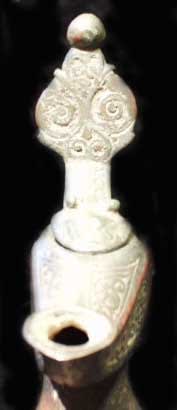Superb, Seljuk Ewer with Oil-Lamp Spout, 11th Century CE - 12th Century CE
bronze and Silver
5.1 x 9.4
JB.1027
Cast bronze ewer with chased decoration over whole and Kufic inscription to shoulder; elegant, pear-shaped body standing upon tall, splayed foot with six-tier rosette in negative relief to underside; spout...
Cast bronze ewer with chased decoration over whole and Kufic inscription to shoulder; elegant, pear-shaped body standing upon tall, splayed foot with six-tier rosette in negative relief to underside; spout in the form of a capped oil-lamp with curving spout and tall reflector flanked by volutes and topped by pearl; undulated handle; decoration to body consists of roundel with harpy – bird with human head – before ground of interlacing vines, all contained within interlacing geometric border; smaller, roundel filled with bird on either side and beyond that, a sprouting floral display; above, inscription, terminates at either end in roundel filled with foliate vine; below, interlacing, geometric motif encircling ground line; interlacing vine to shoulders and lamp; interlacing, geometric motif to handle, as seen on ground line.
This piece is a splendid example of Seljuk metalwork. The Seljuks were a Turkic-Persian dynasty that broke away from the Abbasid caliphate and came to govern a vast area from Hindu Kush to Anatolia, Central Asia to Persian gulf. Under Seljuk helm considerable advancements were made in metalwork. For example, the process of inlay was developed. By 11th-12th centuries, a recognisable Seljuk style, heavily influenced by both Islamic and pre-Islamic cultures had emerged. Rather than ignoring the traditions of the cultures they encountered, the Seljuks incorporated them within their own artistic vocabulary, enriching and enhancing existing techniques and forms.
Through expansion and trade, the Seljuks – and empire at large – came into contact with Late Antique and Byzantine influences in the west and Persian influence in the east.
The spout in the form of a lamp perpetrates a Byzantine tradition for bronze oil lamps that similarly bear tall reflectors. The interlacing, geometric bands also mimic Byzantine motifs. Persian influence is somewhat more overt here. Harpies had been depicted in art for centuries by the time artisans appropriated the motif from the Sassanians who fell to the Arab states in ACE 651. The use of roundels as a key element of the decorative formula, especially when filled with zoomorphic representations also recalls Persian wares. As does, the sprouting floral display.
These motifs are combined with classic elements of the Islamic canon. For example, the arabesque registers. A long tradition for metalwork in Islamic world is attested by the high volume of extant material. Metal objects were highly coveted and commanded a great deal of respect.
While Farsi and a Turkic language were spoken by the Seljuks, the Arabic inscription points to a desire to emulate the Arab states. A veritable tour de force demonstrating not only the level of mastery reached by Seljuk artisans during Medieval period but the spread of new influences across the empire.
This piece is a splendid example of Seljuk metalwork. The Seljuks were a Turkic-Persian dynasty that broke away from the Abbasid caliphate and came to govern a vast area from Hindu Kush to Anatolia, Central Asia to Persian gulf. Under Seljuk helm considerable advancements were made in metalwork. For example, the process of inlay was developed. By 11th-12th centuries, a recognisable Seljuk style, heavily influenced by both Islamic and pre-Islamic cultures had emerged. Rather than ignoring the traditions of the cultures they encountered, the Seljuks incorporated them within their own artistic vocabulary, enriching and enhancing existing techniques and forms.
Through expansion and trade, the Seljuks – and empire at large – came into contact with Late Antique and Byzantine influences in the west and Persian influence in the east.
The spout in the form of a lamp perpetrates a Byzantine tradition for bronze oil lamps that similarly bear tall reflectors. The interlacing, geometric bands also mimic Byzantine motifs. Persian influence is somewhat more overt here. Harpies had been depicted in art for centuries by the time artisans appropriated the motif from the Sassanians who fell to the Arab states in ACE 651. The use of roundels as a key element of the decorative formula, especially when filled with zoomorphic representations also recalls Persian wares. As does, the sprouting floral display.
These motifs are combined with classic elements of the Islamic canon. For example, the arabesque registers. A long tradition for metalwork in Islamic world is attested by the high volume of extant material. Metal objects were highly coveted and commanded a great deal of respect.
While Farsi and a Turkic language were spoken by the Seljuks, the Arabic inscription points to a desire to emulate the Arab states. A veritable tour de force demonstrating not only the level of mastery reached by Seljuk artisans during Medieval period but the spread of new influences across the empire.
